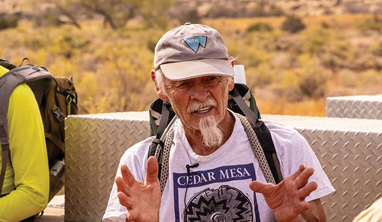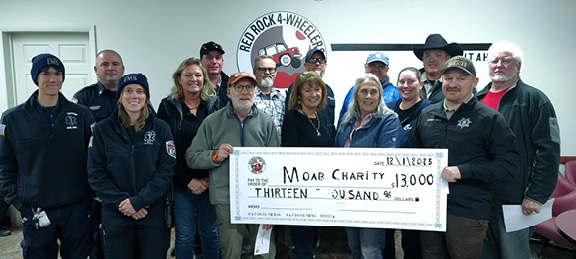Some information may be outdated.
A month after the Moab City Council approved a zoning status agreement that seemed to clear the way for the Lionsback Resort development, critics of the project filed a lawsuit in district court claiming that the council’s decision was illegal.
The agreement, approved 3-2 on Feb. 28, classified changes made to the project since its original proposal as “minor” amendments not subject to a comprehensive public review. Utah’s School and Institutional Trust Lands Administration, which owns the property where the proposed resort would be developed by Invent Development Partners, had made that classification a condition of accepting city jurisdiction over the development. Under state law, SITLA could be exempt from municipal planning and zoning regulations.
But the plaintiffs in the lawsuit — Lucy Wallingford, Kiley Miller, John Rzeczycki, Carol Mayer, David Bodner, Meeche Bodner, Sarah Stock, Josephine Kovash and the nonprofit conservation organization Living Rivers — contend that the changes should have been classified as “major” amendments, as city attorney Chris McAnany had recommended. On March 30, they filed their complaint asking the 7th District Court to nullify the city council’s decision and order public hearings.
“The main argument is this is a major change, and according to zoning laws, they need to present this to the public for their comment and concerns,” Living Rivers Conservation Director John Weisheit said. “And the concerns are many.”
Living Rivers is providing the financial support for the litigation. The organization also supported previous litigation against the Lionsback development in 2008.
“I was asked by the community to do this, and that’s my job: I respond to the desires of the community,” Weisheit said.
The plaintiffs are represented by attorneys Barbara Polich and George Poulton of Salt Lake City law firm Antczak Polich Law. Under the terms of the Feb. 28 agreement, SITLA accepted responsibility for the city’s legal defense in the event of a lawsuit based on the minor changes classification.
“We’re not surprised that this was filed, but we’re going to review the litigation and respond appropriately,” SITLA Associate Director John Andrews said. Andrews confirmed that SITLA will indemnify the city for the costs of litigation, but declined to comment further on the case. He would not say whether SITLA might consider proceeding on the project without the city’s cooperation.
Carol Mayer, one of the plaintiffs in the suit, said she doesn’t believe that strategy is still feasible.
“I don’t think that SITLA could get away with those bully tactics in this state any longer,” she said.
Mayer, who lives near the site of the proposed development, hopes that the suit will create an opportunity for increased public scrutiny of the project.
“I want Lionsback to be held up against today’s standards, rather than the standards that it was approved in 2008,” Mayer said. “I have nothing to lose and, I think, everything to gain by having this project reevaluated by the public.”
The changes made to the project proposal would triple the number of rooms at the resort — from 50 to 150 — but still leave approximately three-quarters of the property as open space.
“The land can’t take it,” plaintiff Kiley Miller said. “We don’t have the water for these kinds of big developments.”
She opposes the project, believing it would bring water-supply contamination and traffic increases an already-overrun Moab.
“This is what citizens are being forced to do to try to protect the communities they live in,” Miller said of the lawsuit. “Moab is in the eye of big developers now and they want to come in and overbuild the community.”
“SITLA’s been bullying not only the city council, but is basically bullying the citizenry,” she added. “Personally, I would very much like for this development to be scrapped.”
Simultaneously with their litigation, the plaintiffs submitted an appeal to the city’s Appeals Authority, also asking for the reversal of the Feb. 28 decision. Weisheit said that the Appeals Authority process is not clearly defined.
“Apparently it has never been used until yesterday,” he said, the day after submitting both the appeal and the lawsuit. “Because of the uncertainty of how the appeals process works, we just filed anyway, to cover our bases.”
Moab City Manager David Everitt said that the city, too, was uncertain how the appeals process ought to work in this situation.
“We’re still trying to work through that too, honestly,” Everitt said. “We’re consulting with our attorneys to make sure we’re following the ordinances we have in place regarding Appeals Authority.”
The city’s land use code designates different bodies as the authority depending on where the initial decision was made, he explained, but because the zoning status agreement was a legislative decision by the city council, the appeal might in fact need to be adjudicated by a court.
“My guess is that the recourse is at the district court level,” Everitt said.
He declined to comment on the contents of the lawsuit, saying that the city was still consulting with legal counsel. But a case based on the major-minor change distinction was “not a giant surprise,” he said.
“It had come up that it was a possibility,” he said.
If the court does invalidate the zoning status agreement, SITLA could go forward on the project without the city, he said.
“I don’t know what SITLA’s approach would be,” Everitt said. “It certainly seems like they would still have the option.”
Weisheit said that the lawsuit provides a chance for the community to be heard.
“This has created an opportunity for public involvement. They didn’t have that before, but now they do,” he said. “My hope is the public will step up.”
Invent Development Partners co-founder Michael Badger did not respond to a request for comment. (Badger is also manager of LB Moab Land, the previous developer for the project.)
Plaintiffs claim city council acted improperly
I have nothing to lose and, I think, everything to gain by having this project reevaluated by the public.
Appreciate the coverage? Help keep local news alive.
Chip in to support the Moab Sun News.





